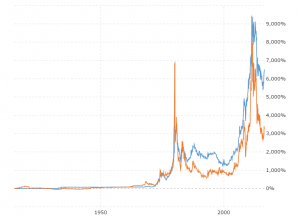Old Gold Worth Saving
Some collectors are torn between collecting for the interest of the coins, and collecting for bullion value, as an investment and even to pass on as an inheritance. One interesting way to balance these desires is to collect old gold. That is, coins from before the Second World War, and even from the 19th century. These will always have bullion value, and they already have some scarcity and collectability value, that can only grow as time passes. So collecting these older coins is a win-win, as their value is almost certainly going to increase in the longer term. In the meantime, you have an interesting collection to pore over and grow.
This option is especially interesting to the younger collector, since it may be 50 years or more before the final value of the collection is realized. With all this in mind, here are some interesting old gold coins that will appeal to any collector, for numismatic and bullion value.
The big turning point date for gold coins in 1933. In that year all Americans were ordered to turn in their gold coins for face value, and gold coins ceased to be a circulation coin. To avoid the loss, many people sent their gold overseas, which for collectors is a good thing, since many rare dates and variations were preserved for future collectors. After that time cheaper metals were used for circulation coins, but to have had a literal ‘pocket full of gold’ must have been a special experience for those old timers.
$20 Gold Liberty Coin
One of the most widely-known old gold coins is the $20 Gold Liberty. In the early decades of the 19th century, the largest coin in circulation in the USA was the $10 Indian Head and Eagle coins. Demand for a large coin grew as an abundance of gold came out of the ground in California during the Gold Rush years. The coin finally struck, and first minted in 1850, was the $20 Liberty gold coin.
The design features Lady Liberty wearing a crown, with hair curling down her neck. She is surrounded by a border of stars, with the issue date beneath. The design is Greco-Roman, and the word ‘Liberty’ can be seen on the crown. The reverse shows a version of the Great Seal of the United States, with TWENTY DOLLARS below and UNITED STATES OF AMERICA above. The design was created during a politically-charged period at the US Mint, by Chief Engraver James Barton Longacre.
The earliest issues, called ‘Type I’ are the rarest, with dates from 1850 to 1866. From then until 1876 the words IN GOD WE TRUST we added above the eagle’s head. These Type 2 are more common, and the design continued for a Type 3, until 1907. The largest number were minted in Philadelphia in 1904, so this is the commonest date seen on these coins.
Because these coins contain almost an ounce of gold, many counterfeits were made, particularly in Lebanon. These are good enough to fool a beginner, if not an expert, so if you are just starting out in the coin world, make sure your coin has been properly assessed and graded.








